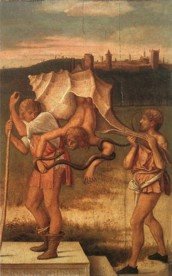This is why yesterday's news from Lancaster shocked me. Why would anyone want to hurt these people? What could possibly have been going through this man’s head that would lead him to such an act? In fact, I ask these questions every time I read about people capable of extreme cruelty – suicide bombers, serial killers, child abusers. I struggle to wrap my brain around the kind of thinking that could motivate and justify these crimes. I guess that’s why we call it senseless violence.
I am far from figuring it all out, but I think it has something to do with the human capacity to lie and be lied to. I don’t mean the way people lie to each other – although judging from current politics, we’re mighty good at that too. I mean the way we lie to ourselves. I first got this idea from the existentialist philosopher Jean-Paul Sartre. According to Sartre, we are strangely capable of lying to ourselves in a process he calls “bad faith.” This self-deception allows us to say that we are not to blame for our own actions because we are acted upon. We are only victims of our circumstances. We are compelled to do what we do.
When on any given day my three boys have transformed from dear little snips and snails and puppy dog tails into typhoon gales and banshee wails, how do I cope? I’ll tell you how I cope. I think “must have chocolate!” You’d be amazed by the lies I then tell myself.
“Self,” I say, “you deserve this, you are entitled to this, and you really have no other choice but to eat this chocolate. Better yet, self, let’s make us a big batch of cookies. It’s on me.”
The irony is of course that the one doing the lying and the one being lied to are one and the same. I know that my excuses are not true but at the same time, I am thoroughly convinced by them. Why? Because otherwise I’d have to bother with painful things like pricks of conscience. I’d have to admit that chocolate has consequences and regardless of my upbringing, my environment, and the decibel level in my home, I am responsible for my own actions.
I think that, because it has the power to kill pain and dull the senses, bad faith is like a drug. Perhaps if a person allowed this kind of deceit to habitually poison his whole system of reasoning, he could eventually be capable of acts that otherwise would be considered unthinkable. This is the only explanation I have for how a person could ever shoot innocent children.
Coming up with a painting to go along with this topic was not easy. But here’s one I think fits: Falsehood by Giovanni Bellini.
 It’s an odd painting – one that raises lots of immediate questions. Well, really just one big question: Why on earth are two guys carrying a shell with a nude snake charmer falling out of it? Here’s my interpretation.
It’s an odd painting – one that raises lots of immediate questions. Well, really just one big question: Why on earth are two guys carrying a shell with a nude snake charmer falling out of it? Here’s my interpretation. To start with, the painting is an allegory, so to figure out which figure is meant to personify Falsehood, we’ll use Julie’s Foolproof Method for Decoding Allegories: “When in doubt, always go with the naked dude.” Yup. It’s pretty sophisticated, I know, but it usually works.
The naked dude (Falsehood) holds a serpent, a common symbol of deceit. He lives in a conch shell, which is a nice metaphor for both something that hides and something that spirals up gradually from a small point to a much larger opening – as lies often do. The most interesting aspect of the painting to me is that the men willingly carry this shell, despite the fact that it looks rather unwieldy and they could just put the silly thing down and walk away. And that’s the whole point. Lies cannot exist unless we willingly carry them. Like a virus that can only survive by being hosted and passed around, falsehood has no legs of its own and can only be transported by others.
The connection to “bad faith” comes when you see the painting’s companion piece, also an allegory, called Prudence. Prudence means the ability to govern and discipline oneself by the use of reason. Since Julie’s Foolproof Method for Decoding Allegories still applies, and Prudence is in this case a woman…..I’ll spare you the full view and focus in on the one detail that I consider the most applicable: the mirror she holds in her hand.
 To govern oneself requires reflection. To live a good life – a life of tough decisions and discipline – you have to face yourself frequently in the mirror. And then be honest about what you see.
To govern oneself requires reflection. To live a good life – a life of tough decisions and discipline – you have to face yourself frequently in the mirror. And then be honest about what you see.Tags: parenting, art, Sartre, school shootings, Amish, bad faith,



2 comments:
Nice sidebar--with a big thank you. I'm afraid I'm a little rusty on my Sartre, just a little Camus here and there, so it feels good to learn a bit of something. Excellent post.
Very interesting post and painting. I just read a book about self deception too! "Bonds That Make Us Free" It was excellent.
Post a Comment